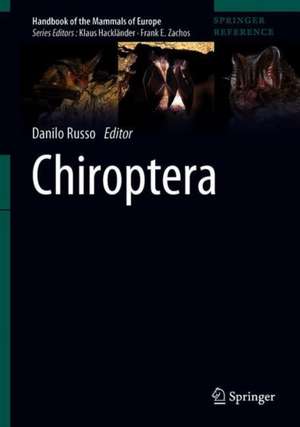Chiroptera: Handbook of the Mammals of Europe
Editat de Danilo Russoen Limba Engleză Hardback – dec 2023
Preliminary
This volume provides comprehensive overviews of each European bat species’ biology including palaeontology, physiology, genetics, reproduction and development, ecology, habitat, diet, mortality and age determination. Their economic significance and management, as well as future challenges for research and conservation are also addressed. Each chapter includes a distribution map, a photograph of the animal and key literature. This authoritative volume of the Handbook of the Mammals of Europe is a timely and detailed compilation of all European bats and will appeal to academics, students and professionals in mammal research.Preț: 2532.09 lei
Preț vechi: 3087.91 lei
-18% Nou
Puncte Express: 3798
Preț estimativ în valută:
484.58€ • 500.59$ • 403.29£
484.58€ • 500.59$ • 403.29£
Carte disponibilă
Livrare economică 05-19 martie
Preluare comenzi: 021 569.72.76
Specificații
ISBN-13: 9783030440282
ISBN-10: 3030440281
Pagini: 963
Ilustrații: XVII, 963 p. 214 illus., 170 illus. in color.
Dimensiuni: 178 x 254 mm
Greutate: 2.22 kg
Ediția:1st ed. 2023
Editura: Springer International Publishing
Colecția Springer
Seria Handbook of the Mammals of Europe
Locul publicării:Cham, Switzerland
ISBN-10: 3030440281
Pagini: 963
Ilustrații: XVII, 963 p. 214 illus., 170 illus. in color.
Dimensiuni: 178 x 254 mm
Greutate: 2.22 kg
Ediția:1st ed. 2023
Editura: Springer International Publishing
Colecția Springer
Seria Handbook of the Mammals of Europe
Locul publicării:Cham, Switzerland
Cuprins
Preliminary (species list)
Tadarida teniotis (Rafinesque, 1814) – European free-tailed bat.- Rhinolophus ferrumequinum (Schreber, 1774) – greater horseshoe bat.- Rhinolophus hipposideros (Bechstein, 1800) – lesser horseshoe bat.- Rhinolophus euryale Blasius, 1853 – Mediterranean horseshoe bat.- Rhinolophus blasii Peters, 1866 – Blasius’ horseshoe bat.- Rhinolophus mehelyi Matschie, 1901 – Mehely’s horseshoe bat.- Barbastella barbastellus (Schreber, 1774) – barbastelle.- Eptesicus serotinus (Schreber, 1774) – serotine.- Eptesicus nilssonii (Keyserling & Blasius, 1839) – northern bat.- Eptesicus bottae (Peters, 1869) – Botta’s serotine.- Hypsugo savii (Bonaparte, 1837) – Savi’s pipistrelle.- Miniopterus schreibersii (Kuhl, 1817) – Schreiber’s bat, bent-winged bat.- Myotis daubentonii (Kuhl, 1817) –Daubenton’s bat.- Myotis capaccinii (Bonaparte, 1837) – long-fingered bat.- Myotis dasycneme (Boie, 1825) – pond bat.- Myotis brandtii (Eversmann, 1845) – Brandt’s bat.- Myotis mystacinus (Kuhl, 1817) – whiskered bat.- Myotis aurascens Kusjakin, 1935 – steppe whiskered bat, Eastern whiskered bat.- Myotis alcathoe von Helversen & Heller, 2001 – Alcathoe’s bat, nymph bat.- Myotis emarginatus (Geoffroy, 1806) – Geoffroy’s bat.- Myotis nattereri (Kuhl, 1817) – Natterer’s bat.- Myotis bechsteinii (Kuhl, 1817) – Bechstein’s bat.- Myotis myotis (Borkhausen, 1797) – greater mouse-eared bat.- Myotis blythii (Tomes, 1857) – lesser mouse-eared bat.- Myotis punicus (Felten, 1977) – Maghrebian mouse-eared bat.- Nyctalus azoreum (Thomas, 1901) – Azores noctule.- Nyctalus noctula (Schreber, 1774) – noctule.- Nyctalus leisleri (Kuhl, 1817) – Leisler’s noctule Nyctalus lasiopterus (Schreber, 1780) – greater noctule.- Pipistrellus pipistrellus (Schreber, 1774) – common pipistrelle, 45 kHz pipistrelle.- Pipistrellus pygmaeus (Leach, 1825) – soprano pipistrelle, midge bat, 55 kHz pipistrelle.- Pipistrellus nathusii (Keyserling & Blasius, 1839) – Nathusius’ pipistrelle.- Pipistrellus kuhlii (Kuhl, 1817) – Kuhl’s pipistrelle.- Pipistrellus maderensis Dobson, 1878 – Madeiran pipistrelle.- Plecotus teneriffae Barrett-Hamiton, 1907 – Canary long-eared bat.- Plecotus auritus (Linnaeus, 1758) – common long-eared bat, brown long-eared bat.- Plecotus austriacus (Fischer, 1829) – grey long-eared bat.- Plecotus macrobullaris (Kusjakin, 1965) – Alpine long-eared bat.- Plecotus kolombatovici (Dulic, 1980) – Kolombatovic’s long-eared bat, Balkan long-eared bat.- Plecotus sardus Mucedda & Kiefer, 2002 – Sardinian long-eared bat.- Vespertilio murinus Linnaeus, 1758 – parti-coloured bat.
Notă biografică
Preliminary
Danilo Russo is an animal ecologist mainly working on vertebrates (especially bats and more recently rodents) but also on a flagship long-horned beetle, the Rosalia longicorn (Rosalia alpina). His research interests cover a range of topics, including habitat selection, resource partitioning, sensory ecology, social behaviour, evolutionary biology, biogeography and conservation biology. He is currently leading Wildlife Research Unit at University of Naples Federico II.
Caracteristici
Comprehensive overviews of each European bat species’ biology Each species account includes a distribution map, a photograph and key literature For academics, students, & professionals in mammal research, conservation, & management





